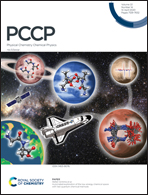Effects of fixed charge group physicochemistry on anion exchange membrane permselectivity and ion transport†
Abstract
Understanding the effects of polymer chemistry on membrane ion transport properties is critical for enabling efforts to design advanced highly permselective ion exchange membranes for water purification and energy applications. Here, the effects of fixed charge group type on anion exchange membrane (AEM) apparent permselectivity and ion transport properties were investigated using two crosslinked AEMs. The two AEMs, containing a similar acrylonitrile, styrene and divinyl benzene-based polymer backbone, had either trimethyl ammonium or 1,4-dimethyl imidazolium fixed charge groups. Membrane deswelling, apparent permselectivity and ion transport properties of the two AEMs were characterized using aqueous solutions of lithium chloride, sodium chloride, ammonium chloride, sodium bromide and sodium nitrate. Apparent permselectivity measurements revealed a minor influence of the fixed charge group type on apparent permselectivity. Further analysis of membrane swelling and ion sorption, however, suggests that less hydrophilic fixed charge groups more effectively exclude co-ions compared to more hydrophilic fixed charge groups. Analysis of ion diffusion properties suggest that ion and fixed charge group enthalpy of hydration properties influence ion transport, likely through a counter-ion condensation, ion pairing or binding mechanism. Interactions between fixed charge groups and counter-ions may be stronger if the enthalpy of hydration properties of the ion and fixed charge group are similar, and suppressed counter-ion diffusion was observed in this situation. In general, the hydration properties of the fixed charge group may be important for understanding how fixed charge group chemistry influences ion transport properties in anion exchange membranes.



 Please wait while we load your content...
Please wait while we load your content...